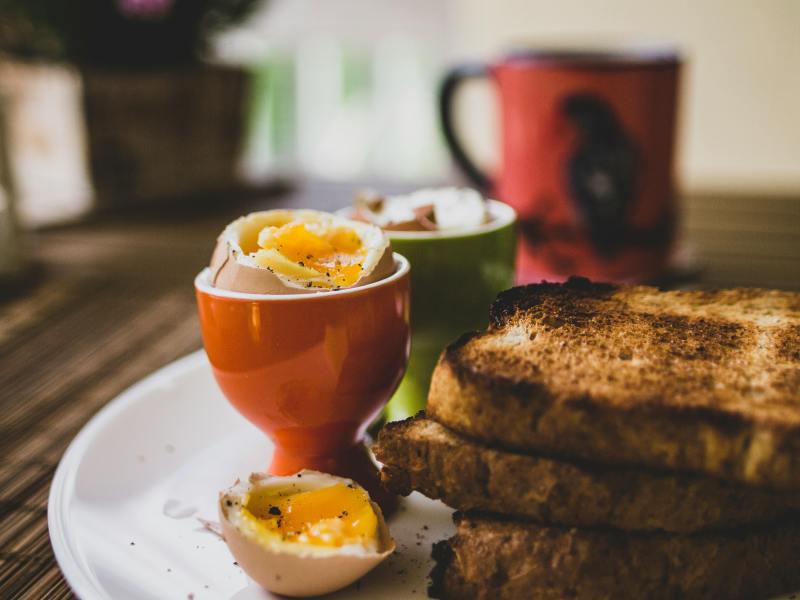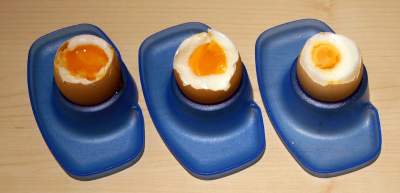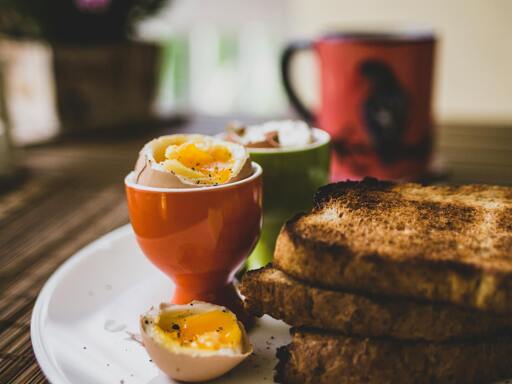
Many of us have boiled an egg at some point or another in our lives. The conventional technique is relatively straightforward—get the water boiling, drop the egg in, and leave it for a certain period of time based on the desired consistency. If you want the yolk soft, only leave it in for a few minutes, and if you want it hard, go longer.
Ultimately, though, this is a relatively crude system for controlling the consistency of the final product. If you instead study the makeup of the egg, and understand how it works, you can elicit far greater control over the texture and behavior of your egg with great culinary benefits.
Knockin’ On 64
 Traditional boiled eggs cooked for 4 minutes, 7 minutes, and 9 minutes. When cooking in boiling water, temperatures are high enough to create a fully firm white in just a few minutes. Credit: Wikisearcher, CC BY-SA 3.0
Traditional boiled eggs cooked for 4 minutes, 7 minutes, and 9 minutes. When cooking in boiling water, temperatures are high enough to create a fully firm white in just a few minutes. Credit: Wikisearcher, CC BY-SA 3.0
It all comes down to the physical basics of what goes on when we cook an egg. Whether frying, poaching, or simply boiling, one thing is the same—the liquid contents of the egg turn more solid with heat. This is because the heat causes the proteins in the egg white and egg yolk to *denature—*they untangle and unravel from their original folded structure into a new form which is the one we prefer to eat.
Physical chemist Hervé This is widely credited as revolutionizing the way we think about cooking eggs, through his careful study of how temperature affected the cooking process of a “boiled” egg. He invented the idea of the “6X °C egg”—a method of cooking eggs to generate a pleasant, smooth consistency by carefully controlling how the proteins denature. His work has since been expanded upon by many other researchers eager to untangle the mysteries of how egg proteins behave with heat.
Different purveyors of these theories each have their own ideals—but it’s common to hear talk of the “64-degree egg” or “65-degree egg.” To create such an egg, one typically uses a sous vide water bath set at a very precise temperature, in order to cook the egg in as controlled a manner as possible. The process is a relationship between time and temperature, and so the cooking times used are a lot longer than with boiling water at 100 C—immersing the eggs for 60 minutes or more is typical. This also helps to ensure the eggs are safe to eat, with the lower temperature needing a longer time to quash potentially harmful bacteria.
Enthusiasts share cooking times and temperatures along with qualitative results, ever searching for the ideal egg.
The results of such a process? Eggs cooked in this manner are prized for their tender yolks and an overall consistency not dissimilar to custard. The process denatures the yolk and white proteins just enough to create an incredibly smooth egg with luxurious mouthfeel, and they’re often cited as melting in the mouth.
 The onsen egg from Japan is a traditional egg dish cooked at approximately 70 C for 30 to 40 minutes, similarly creating an egg with a luxurious consistency. Credit: Blue Lotus, CC BY 2.0
The onsen egg from Japan is a traditional egg dish cooked at approximately 70 C for 30 to 40 minutes, similarly creating an egg with a luxurious consistency. Credit: Blue Lotus, CC BY 2.0
The only real drawback? It’s typical to get some runny whites left over, since the low cooking temperature isn’t enough to fully denature the proteins in that part of the egg. These eggs were once a neat science experiment from the world of molecular gastronomy, with the cooking method since becoming widespread with restaurants and sous vide enthusiasts around the world.
There are even more advanced techniques for those committed to egg perfection. A research team from the University of Naples, Italy, determined that cycling an egg between two pans—one with boiling water, the other at 30 C—allowed both the yolk and the white to each reach target doneness. To get the whites to around 85 C while holding the yolk at 65 C, the team used the technique of swapping between pans to get both to their ideal temperature by modelling heat transfer through the egg. This controls the amount of heat transferred to the yolk deeper inside the egg, ensuring that it’s not overcooked in the effort to get the whites to set. Ultimately, though, this process requires a great deal of work swapping the egg back and forth for a full 30 minutes.
Few make that sort of commitment to eggcellence.
Featured image, the imaginatively named “Selective Photography of Breakfast in Plate” by [Krisztina Papp].
From Blog – Hackaday via this RSS feed


